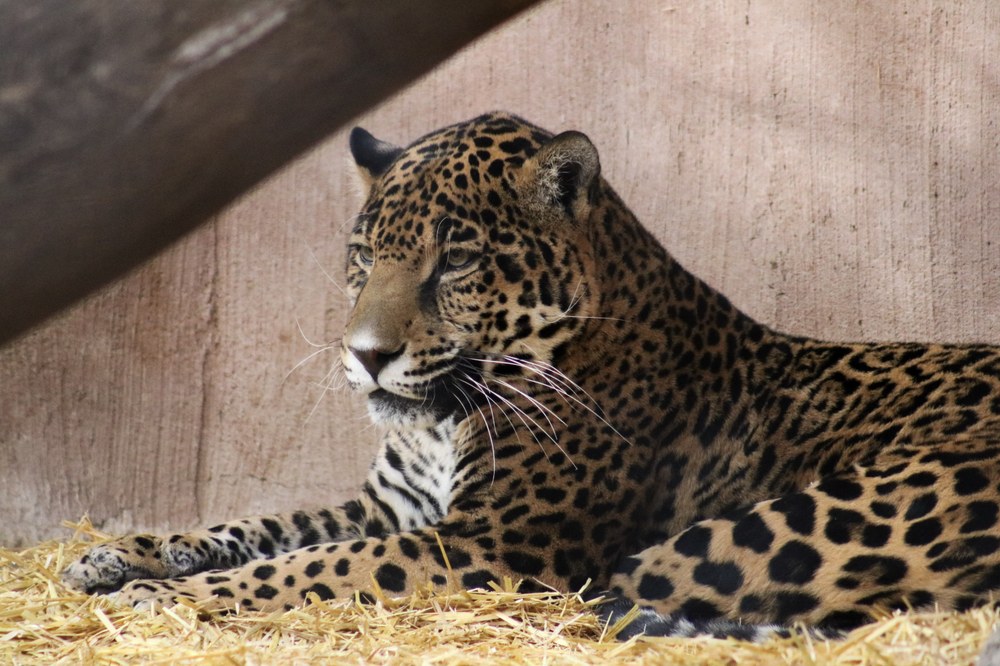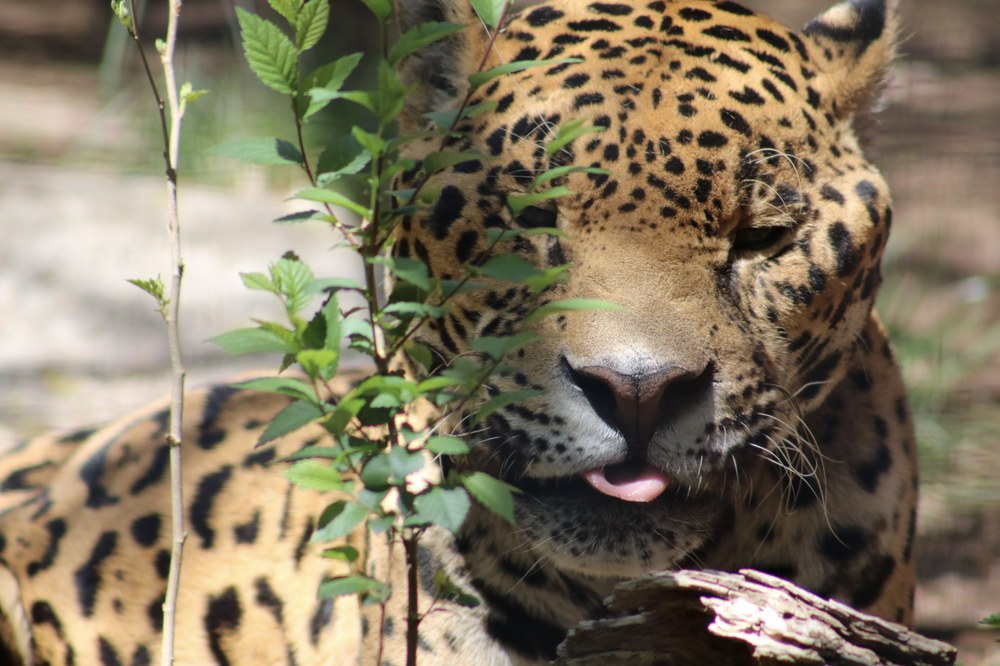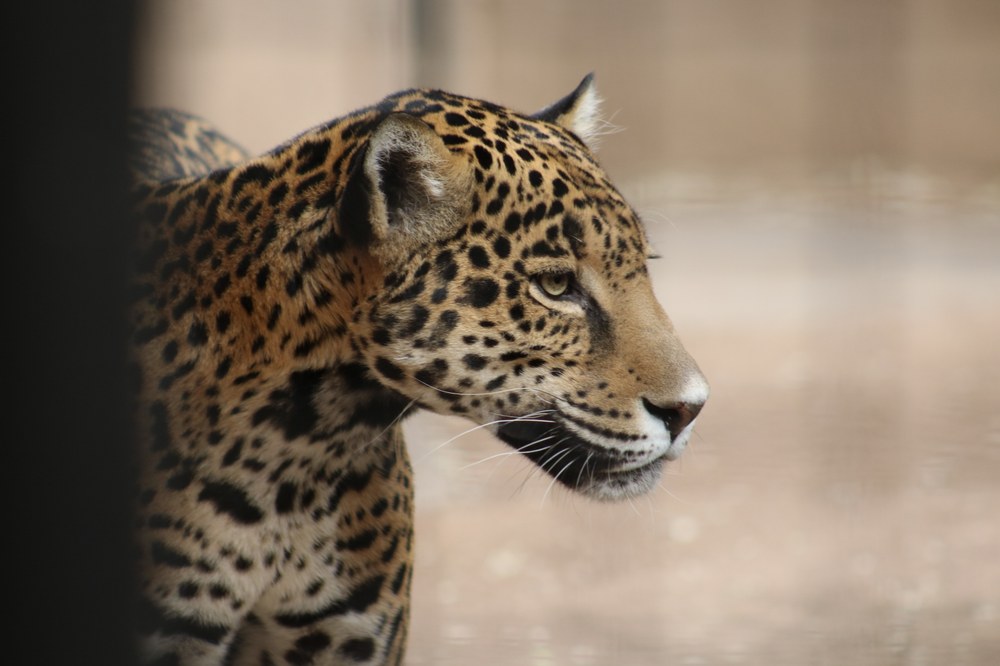Jaguars
Learn about this big cat of the Americas and construct your own jaguar wildlife corridor.
Goal
Learn about the many prey species a jaguar is capable of hunting and how wildlife corridors help these amazing cats.
Introduction to Animal

Let’s sneak into the stealthy world of jaguars! These magnificent and fierce hunters are at the top of the food chain and can be found in tropical forests like the Amazon rainforest. These cats prefer to be in the lowlands where ponds, marshes, streams and plenty of prey can be found. Unlike some big cats, jaguars will even follow their prey into the water to catch them.
Jaguars live alone and are territorial over the area they live in, allowing them to protect their range and the area they hunt within. This isolation allows them to maintain a steady supply of food as long as their range is large enough and there is enough habitat available for all jaguars. The only time a jaguar is not alone is to mate, or when a mother is raising her young. Jaguar mothers have one to four cubs and will stay with them for about two years during which she teaches her cubs to hunt, before the cubs go off to find their own range.
Jaguars at the ABQ BioPark

Maya is the current resident jaguar at the ABQ BioPark Zoo. At the BioPark we appreciate that all animals are individuals; their names help better tell each animal's story and allow visitors to better connect with them.
The carnivore animal keepers who care for Maya give her lots of enrichment items. Enrichment keeps Maya's life interesting and encourages her to play and use all the areas in her habitat by clawing, jumping and pouncing. As a predator, she has important adaptations to help her find food. Keepers use enrichment through the placement of food, spices and different scents to increase novelty and encourage Maya's natural instincts to explore her habitat. The keepers who work with Maya on a day-to-day basis say that she especially loves the smell of cinnamon, so they place it inside boxes to give Maya a new item and smell to investigate. Maya is also especially stimulated by round objects like balls or pumpkins because she gets the opportunity to fully utilize her powerful jaws and sharp teeth as she grabs onto them and bites down.
Jaguar Conservation

Most jaguars today live in Central and South America, although some jaguars have been “spotted” in areas of the United States like Arizona and New Mexico. In the past 150 years their territory has been reduced by more than 50 percent because of an increasing human presence, which includes road expansion and building development.
The jaguar is considered “near-threatened” by the International Union for the Conservation of Nature (IUCN). This “near-threatened” status means that although their population has been reduced and is currently declining, there are still enough jaguars in the wild, so they are not yet considered “endangered” or very close to the brink of extinction. This gives us hope that by protecting jaguar habitat, humans can continue to reverse their population decline. Having jaguars in an ecosystem is important because they play a vital role in controlling numbers of prey species. They are a keystone species, meaning that their presence or absence hugely affects many other types of animals and plants, and the ecosystem as a whole.
Jaguars are highly adaptable for a variety of different environments, even grasslands or mountainous regions. This adaptability is one possible reason jaguars have fared better than other big cat species like the snow leopard. It is estimated that jaguars hunt more than 80 different species including fish, turtles, caiman, deer, peccaries, capybaras and tapirs. This is especially impressive in comparison to a cat like the African lion, which primarily hunts just a few staple prey like wildebeests, antelope and zebras. Although jaguars can eat a large variety of prey, they still need access to enough territory to be able to find and hunt effectively without going hungry.
Jaguars have benefited greatly from the creation of wildlife corridors. The intent of a wildlife corridor is to provide safe passage for an animal, whether that be over an obstacle, across a highway or road, or through a city or town. The more green space and wildlife corridors there are, the more likely it is that animals will be able to find their own territories, mates and resources. Wildlife corridors can look like many different things depending on the environment and animal most targeted for use.
Activity Description: Construct your own Jaguar Corridor
In this activity you can use a large variety of household objects to represent your jaguar habitat. You need items to represent the following: jaguars, prey species, humans, suitable jaguar habitat and boundaries/corridors. To simplify this activity you can also reduce what you use and just use jaguars and humans, or jaguars and prey, or jaguars and habitat.
Activity Materials
Here are some material ideas to get you started:
Jaguars:
- Plastic or stuffed animals
- Drawn/sketched paper jaguars
- Jaguars made from toilet paper tubes
- Spotted buttons
- Interesting rocks
- Coins/nickels
Prey:
- Plastic or stuffed animals
- Drawn/sketched prey species
- Prey made from cotton balls
- Plain buttons
- Plain rocks
- Coins/pennies
Human Cities/Towns:
- Blankets/towels
- Stacks of books
- Chairs/tables
- Building blocks
- Cups
- Cardboard boxes
Habitat:
- Anything green: t-shirts, blankets, towels, etc.
- Houseplants
- Rocks/sticks/leaves
- Drawings
- Plates
- Rooms of your house
Boundaries, Streams, Roads, Bridges, or Wildlife Corridors:
- Scarves, blankets, towels
- Forks/spoons
- Blocks
- Drawings/paper
- Stones/rocks
- Books
Once you have collected together your materials, you can do the following experiments or make up your own to further analyze the possibilities of relationships between jaguars and their environments. These items can be placed on the floor, outside, on a table, or any large space you decide to use for your jaguar map.
Activity Instructions
Build your map and have fun! Remember to keep the questions and hypotheses flowing on all sides by saying things like, “I predict…” or “What would happen if…”. We are all scientists. There are no wrong/right answers for the questions below. They are merely tools for us to use to start to examine complex situations.
- Place habitats to create the basis for your map (1-5). These can be rainforests, ponds, marshes, jungles, mountains or grasslands. Whatever you imagine them to be.
- Add in prey species (5-20). These can be anything from the list below! Jaguars have a huge number of prey.
- Add in a few jaguars (2-4) making sure that they each have their own distinct territory.
- Continue to ask and answer questions and make changes/modifications to your map to see cause and effect.
- What would happen if there were more/less prey?
- What would happen if there were more/less jaguars?
- What would happen if there was more/less habitat?
- Make things more complicated by building human cities and towns (1-3) and moving the animals accordingly.
- Would jaguars want to be close to cities? Are there any problems that might arise with jaguars living closer to humans?
- Add in fences/walls, mountain ranges, rivers, roadways, etc. (2-4); anything that can be classified as a boundary.
- Think about what boundaries you are building. Are they easy to cross or hard to get over? Can the jaguars and the prey animals move around them?
- Finally, add in your wildlife corridors (1-10) connecting habitats to each other. These can be bridges, tunnels, green spaces or anything you think animals would be able to travel through safely.
- What do your corridors connect? Do they change the jaguars' access to prey, territory or other jaguars?
- Added Bonus: Add in some human animals that jaguars see as prey, like dogs or cows.
- How can boundaries help the jaguars and humans have the space they each need?
Jaguars are threatened by the wildlife trade, poaching, habitat loss and conflict with ranchers over cattle. Jaguar corridors and programs that supplement ranchers for any cattle they lose to jaguars are helping to reduce conflict between humans and jaguars. You can help by educating others, supporting the construction of wildlife corridors and visiting and supporting Association of Zoos and Aquariums (AZA)-accredited facilities like the ABQ BioPark.
Additional Resources
Learn more about what our AZA partners are doing.
